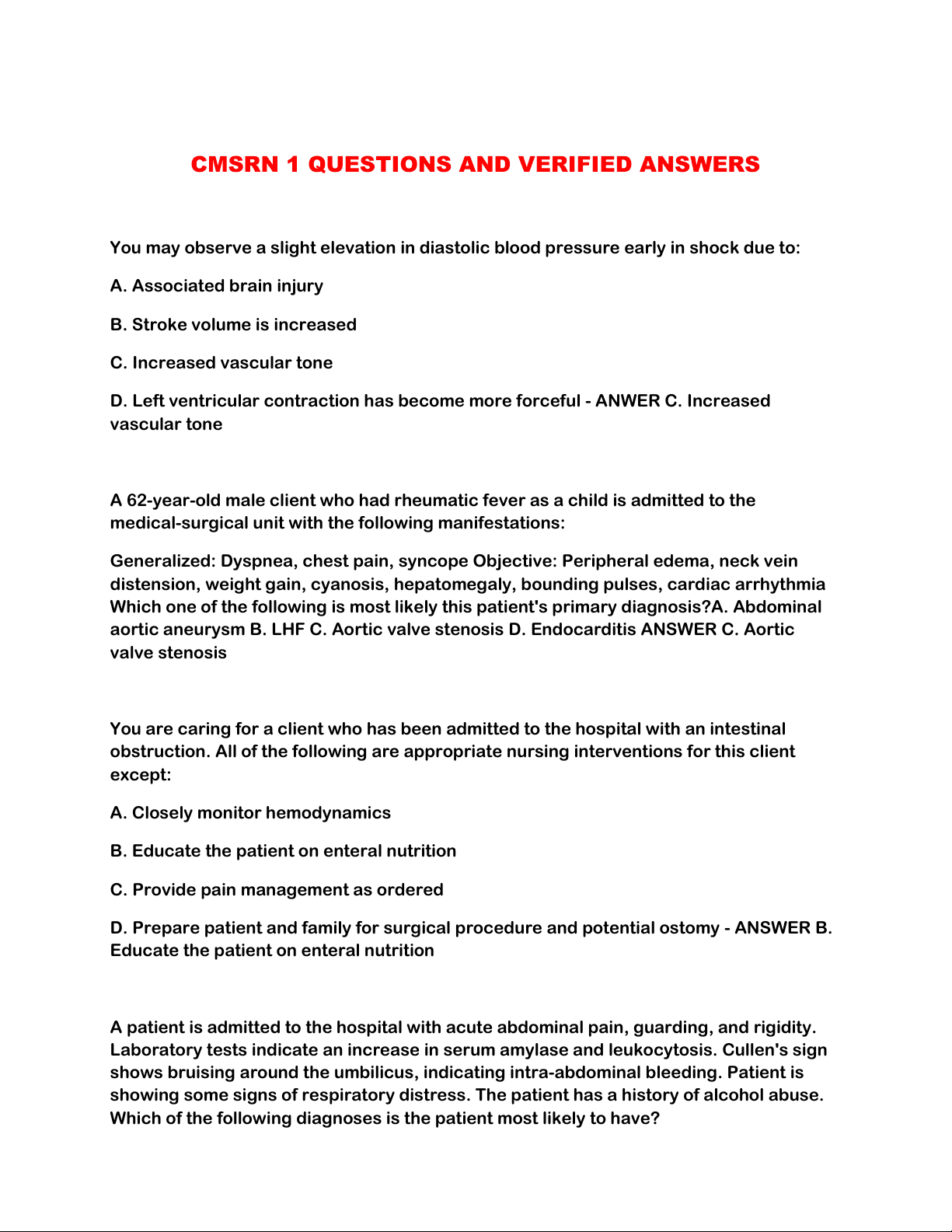
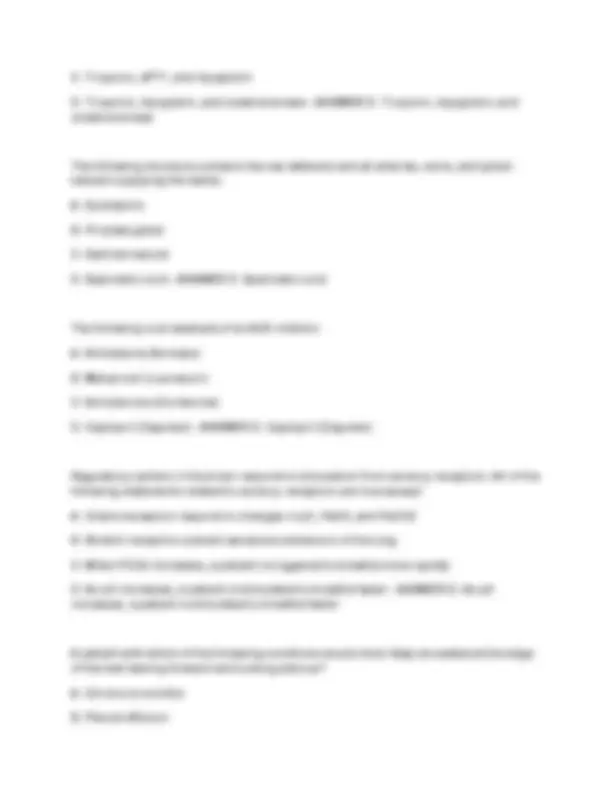
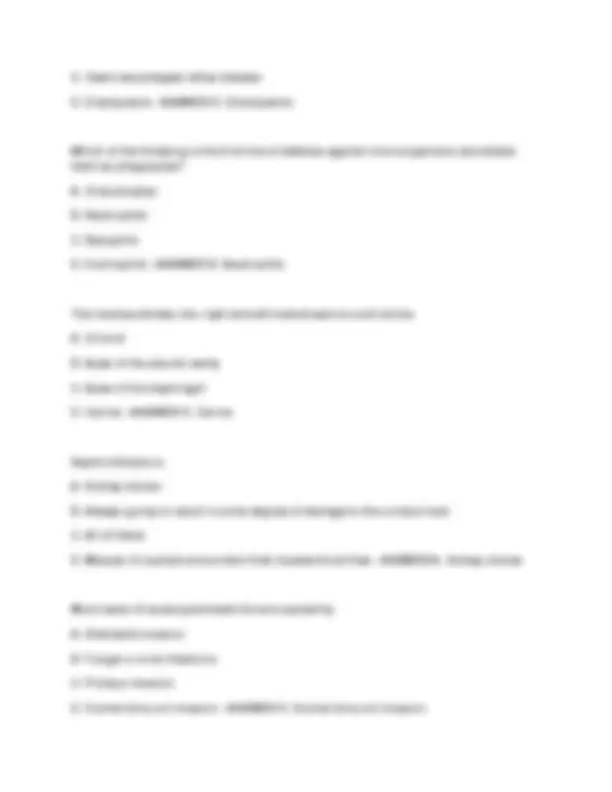
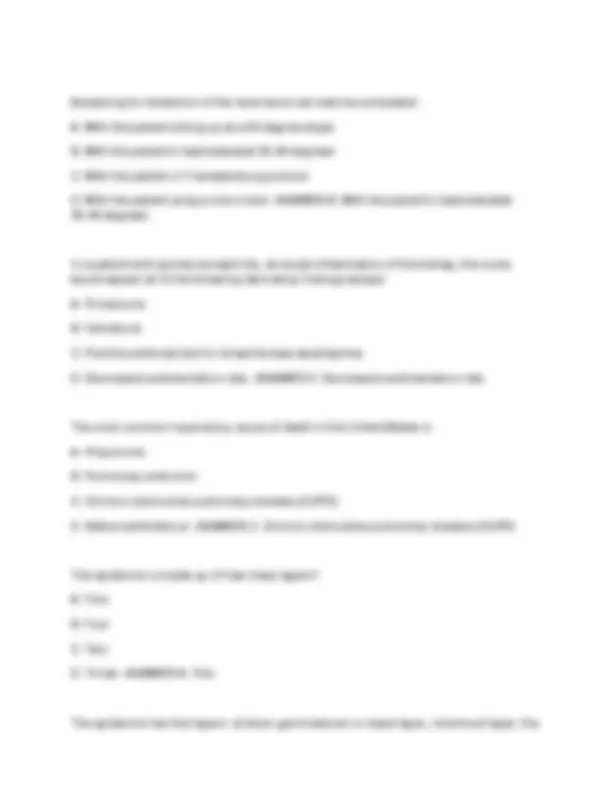
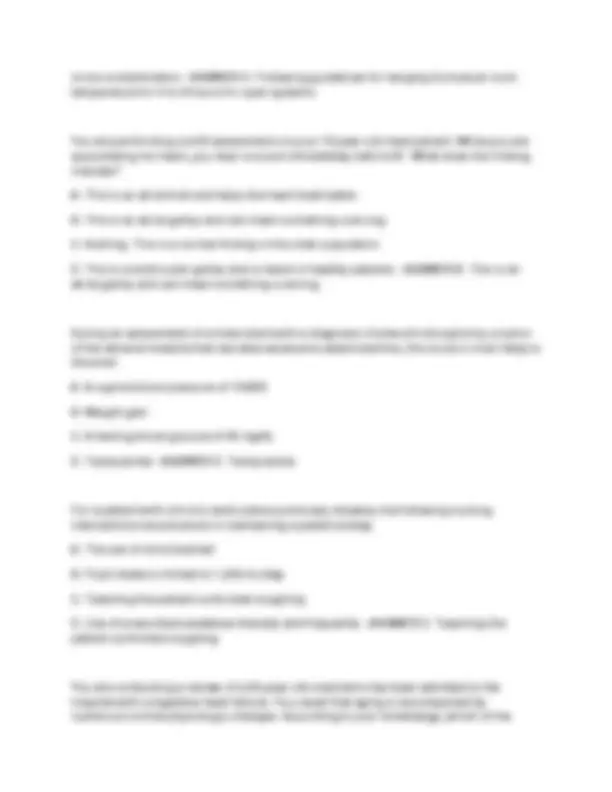
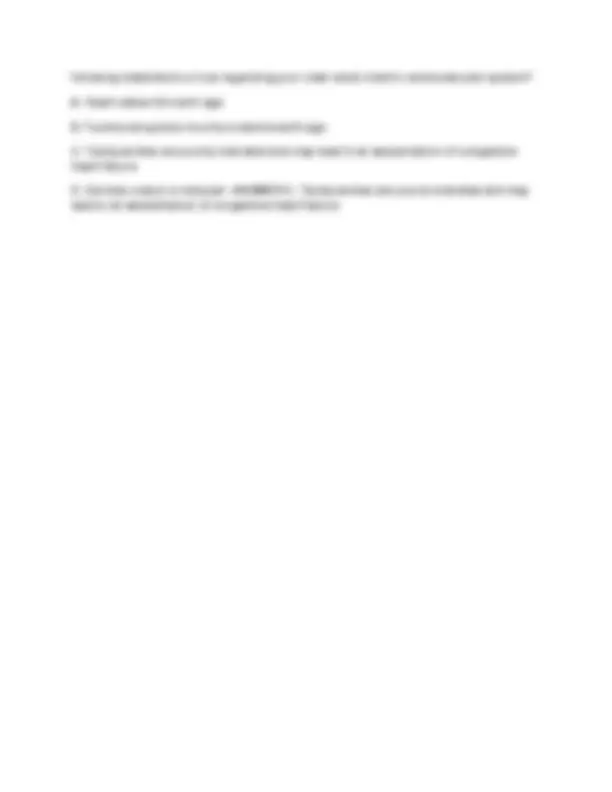


Study with the several resources on Docsity

Earn points by helping other students or get them with a premium plan


Prepare for your exams
Study with the several resources on Docsity

Earn points to download
Earn points by helping other students or get them with a premium plan
Community
Ask the community for help and clear up your study doubts
Discover the best universities in your country according to Docsity users
Free resources
Download our free guides on studying techniques, anxiety management strategies, and thesis advice from Docsity tutors
A valuable resource for students preparing for the cmsrn exam. It features a series of multiple-choice questions and verified answers covering key concepts in cardiovascular, respiratory, and renal systems. the questions assess knowledge of various medical conditions, diagnostic tests, and treatment approaches. This resource is particularly useful for reinforcing learning and identifying areas needing further study. The questions are challenging and cover a wide range of topics, making it a comprehensive study tool.
Typology: Exams
1 / 9

This page cannot be seen from the preview
Don't miss anything!






You may observe a slight elevation in diastolic blood pressure early in shock due to: A. Associated brain injury B. Stroke volume is increased C. Increased vascular tone D. Left ventricular contraction has become more forceful - ANWER C. Increased vascular tone
A 62-year-old male client who had rheumatic fever as a child is admitted to the medical-surgical unit with the following manifestations: Generalized: Dyspnea, chest pain, syncope Objective: Peripheral edema, neck vein distension, weight gain, cyanosis, hepatomegaly, bounding pulses, cardiac arrhythmia Which one of the following is most likely this patient's primary diagnosis?A. Abdominal aortic aneurysm B. LHF C. Aortic valve stenosis D. Endocarditis ANSWER C. Aortic valve stenosis
You are caring for a client who has been admitted to the hospital with an intestinal obstruction. All of the following are appropriate nursing interventions for this client except: A. Closely monitor hemodynamics B. Educate the patient on enteral nutrition C. Provide pain management as ordered D. Prepare patient and family for surgical procedure and potential ostomy - ANSWER B. Educate the patient on enteral nutrition
A patient is admitted to the hospital with acute abdominal pain, guarding, and rigidity. Laboratory tests indicate an increase in serum amylase and leukocytosis. Cullen's sign shows bruising around the umbilicus, indicating intra-abdominal bleeding. Patient is showing some signs of respiratory distress. The patient has a history of alcohol abuse. Which of the following diagnoses is the patient most likely to have?
A. Alcoholic cirrhosis B. Pneumonia C. Acute liver failure D. Acute pancreatitis - ANSWER D. Acute pancreatitis
Your male patient has chronic liver failure and poorly absorbed vitamin K. Which of the following assessment findings suggest a vitamin K deficiency? A. Testicular atrophy and gynecomastia B. Dyspnea and fatigue C. Petechiae and ecchymoses D. Ascites and orthopnea - ANSWER C. Petechiae and ecchymoses
While performing an assessment on a patient with emphysema you note that your patient has a barrel chest. The change in your patient's chest is due to: A. Hyperinflation of the lungs B. Use of accessory muscles C. Chronic hypoxia D. Collapse of distal alveoli - ANSWER A. Hyperinflation of the lungs
Supination is a term that refers to: A. Turning a part toward midline B. Turning a part away from midline C. Turning upward D. Turning upward - ANSWER C. Turning upward
For a diagnosis of MI to be confirmed, the physician would order which laboratory tests? A. Myoglobin, creatine kinase, and sedimentation rate B. Creatine kinase, troponin, and sedimentation rate
C. Gastroesophageal reflux disease D. Emphysema - ANSWER D. Emphysema
Which of the following is the first line of defense against microorganisms and attack them as phagocytes? A. Granulocytes B. Neutrophils C. Basophils D. Eosinophils - ANSWER B. Neutrophils
The trachea divides into right and left mainstream bronchi at the: A. Cricoid B. Apex of the pleural cavity C. Apex of the diaphragm D. Carina - ANSWER D. Carina
Nephrolithiasis is: A. Kidney stones B. Always going to result in some degree of damage to the urinary tract C. All of these D. Masses of crystals and protein that impede blood flow - ANSWER A. Kidney stones
Most cases of acute pyelonephritis are caused by: A. Klebsiella invasion B. Fungal or viral infections C. Proteus invasion D. Escherichia coli invasion - ANSWER D. Escherichia coli invasion
Assessing for distention of the neck veins can best be completed: A. With the patient sitting up at a 90-degree angle B. With the patient's head elevated 30-45 degrees C. With the patient in Trendelenburg position D. With the patient lying prone in bed - ANSWER B. With the patient's head elevated 30-45 degrees
In a patient with glomerulonephritis, an acute inflammation of the kidney, the nurse would expect all of the following laboratory findings except: A. Proteinuria B. Hematuria C. Positive antibody test for streptokinase exoenzymes D. Decreased sedimentation rate - ANSWER D. Decreased sedimentation rate
The most common respiratory cause of death in the United States is: A. Pneumonia B. Pulmonary embolism C. Chronic obstructive pulmonary disease (COPD) D. Status asthmaticus - ANSWER C. Chronic obstructive pulmonary disease (COPD)
The epidermis is made up of how many layers? A. Five B. Four C. Two D. Three - ANSWER A. Five
The epidermis has five layers: stratum germinativum or basal layer, innermost layer; the
Acute lymphocytic leukemia (ALL) has median age of presentation at: A. 15 years of age B. 4 years of age C. 50 years of age D. 60 years of age - ANSWER B. 4 years of age
An esophageal obstruction is typically described as any blockage of the passage of food through the gastrointestinal tract. Which of the following is a common cause of an esophageal obstruction? A. Gastroesophageal reflux disease B. Esophageal tumors C. Achalasia D. Infection - ANSWER A. Gastroesophageal reflux disease
All of the following medications are contraindicated in type 1 diabetes mellitus except: A. Glimepiride (Amaryl) B. Pramlintide (Symlin) C. Metformin extended release (Glucophage XR) D. Glipizide (Glucotrol) - ANSWER B. Pramlintide (Symlin)
Enteral feeding products come from manufacturers in ready-to-feed cans, powders that require reconstituting, or in pre-filled bags that are ready to be spiked. Bacterial contamination of the formula can be reduced by: A. Discarding refillable bags every 48 hours B. Refrigerating reconstituted formulas for no more than 72 hours C. Following guidelines for hanging formula at room temperature for 4 to 8 hours for open systems D. Prepare, dilute, and reconstitute formulas in the patient's room to prevent
cross-contamination - ANSWER C. Following guidelines for hanging formula at room temperature for 4 to 8 hours for open systems
You are performing a shift assessment on your 72-year-old male patient. While you are auscultating his heart, you hear a sound immediately before S1. What does this finding indicate? A. This is an atrial kick and helps the heart beat better. B. This is an atrial gallop and can mean something is wrong. C. Nothing. This is a normal finding in the older population. D. This is a ventricular gallop and is heard in healthy patients - ANSWER B. This is an atrial gallop and can mean something is wrong
During an assessment of a male client with a diagnosis of pheochromocytoma, a tumor of the adrenal medulla that secretes excessive catecholamine, the nurse is most likely to discover: A. A supine blood pressure of 100/ B. Weight gain C. A fasting blood glucose of 60 mg/dL D. Tachycardia - ANSWER D. Tachycardia
For a patient with chronic obstructive pulmonary disease, the following nursing interventions would assist in maintaining a patent airway: A. The use of strict bedrest B. Fluid intake is limited to 1,000 mL/day C. Teaching the patient controlled coughing D. Use of prescribed sedatives liberally and frequently - ANSWER C. Teaching the patient controlled coughing
You are conducting a review of a 90-year-old client who has been admitted to the hospital with congestive heart failure. You recall that aging is accompanied by numerous normal physiologic changes. According to your knowledge, which of the